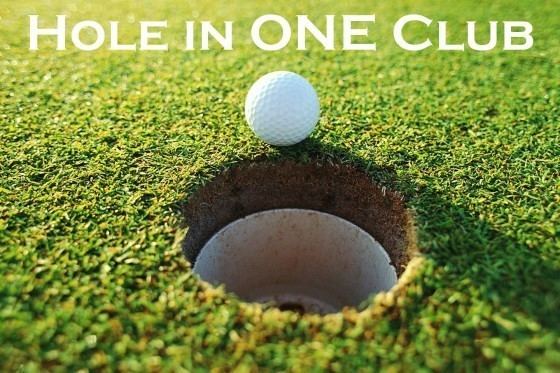Golf hole in one compilation
In golf, a hole in one or hole-in-one (also known as an ace, mostly in American English) is when a ball hit from a tee shot finishes in the cup. This awards the player a score of one for the hole. Holes in one most commonly occur on par 3 holes, the shortest distance holes on a standard size golf course. Longer hitters have also accomplished this feat on longer holes, though nearly all par 4 and par 5 holes are too long for golfers to reach in a single shot. While well known outside of golf and often requiring a well hit shot and significant power, holes in one are considered to also contain an element of luck. As such, they are more common and considered less impressive than other hole accomplishments such as completing a par 5 in two shots (an albatross). As of October 2008, a condor (four under par) hole-in-one on a par 5 hole had been recorded on four occasions, aided by thin air at high altitude, or by cutting the corner on a doglegged or horseshoe-shaped hole.
Contents
- Golf hole in one compilation
- Tiger woods hole in one
- Rarity
- Competitions
- Holes in one on par 5 or higher holes
- Kim Jong il myth
- References

Holes-in-one ("aces") are also recorded in the sport of disc golf, in which a round plastic disc is thrown toward a metal basket-shaped target.

Tiger woods hole in one
Rarity

Holes in one are rare, and, although skill definitely increases the probability, there is a great element of luck involved. It is traditional for a player who has scored a hole in one to buy a round of drinks for everyone at the clubhouse bar.

Among the memorable holes in one, one occurred in the 1973 British Open when at age 71, Gene Sarazen made a hole in one. Earl Dietering of Memphis, Tennessee, 78 years old at the time, is believed to hold the record for the oldest person to make a hole-in-one twice during one round.
During the second round of the 1971 Martini International tournament, held at the Royal Norwich Golf Club in England, John Hudson had two consecutive holes in one. Teeing off, using a 4-iron, at the par-three, 195-yard 11th hole, Hudson holed his tee shot for a hole-in-one. At the next hole, the downhill 311-yard, par-four 12th, and this time using a driver, he once again holed his tee shot, for another ace. This is believed to be the only time a player has scored holes-in-one at consecutive holes in a major professional tournament.

Despite the relative rarity of holes in one, there have been a total of six in Ryder Cup matches. Peter Butler scored the first in 1973 at Muirfield followed by a 20-year gap before Nick Faldo scored a hole in one in 1993. Two years later, Costantino Rocca and Howard Clark both scored holes in one before an 11-year gap to 2006 saw Paul Casey and Scott Verplank both hole out in one on the 14th hole.
On August 11, 2016, Justin Rose shot a hole in one during the first round of the golf tournament of the 2016 Summer Olympics in Rio de Janeiro, which is considered to be the first one in the Olympic history. For the 189 yards 3-par hole, he used a 7-iron.
Competitions
Occasionally special events host a hole in one contest, where prizes as expensive as a new car, or cash awards sometimes reaching $4 million are offered if a contestant records a hole in one. Usually such expensive prizes are backed by an insurance company who offers prize indemnification services. Actuaries at such companies have calculated the chance of an average golfer making a hole in one at approximately 12,500 to 1, and the odds of a tour professional at 2,500 to 1.
Holes-in-one on par 5 (or higher) holes
As of October 2008, a condor (four under par) hole-in-one on a par 5 hole had been recorded on four occasions, aided by thin air at high altitude, or by cutting the corner on a doglegged or horseshoe-shaped hole. A horseshoe-shaped par 5 hole once enabled a condor hole in one to be achieved with a 3-iron club, and in theory a hole-in-one could be scored on a horseshoe-shaped par 6 hole, but par 6 holes are exceptionally rare, and so far (as of October 2008) there has not even been a hole-in-two recorded on a par 6. Similar comments apply to par-seven holes. The longest recorded straight drive hole-in-one is believed to be 517 yards or 473 metres, by Mike Crean at the par 5 No. 9 hole at Green Valley Ranch Golf Club in Denver in 2002, aided by the thin air due to the high altitude. None of these four par 5 holes-in-one were achieved during a professional tournament. A condor is also known as a double albatross, or a triple eagle.
Kim Jong-il myth
Over a period of several years, many U.S. and European media outlets – including ESPN and the New York Times – reported that former North Korean Supreme Leader Kim Jong-il was claimed to have shot five holes in one during his first attempt at playing golf (an alternate version of the story claims North Korean media once reported Kim had shot 18 holes in one). This is explained as a case of the North Korean government assigning supernatural feats of heroism to its leaders as part of an effort to perpetuate a cult of personality. This myth was originally told as fact by a Pyongyang Golf Club professional to Eric Ellis, a reporter for the Australian Financial Review who visited the club in 1994. NK News reports that "informal surveys of North Koreans themselves revealed that no one in Pyongyang was aware of this legendary feat, unless told it by a tourist." Richard Seers, a British journalist who played at the Pyongyang Golf Club asked officials there, who revealed it was nothing more than an urban myth.
